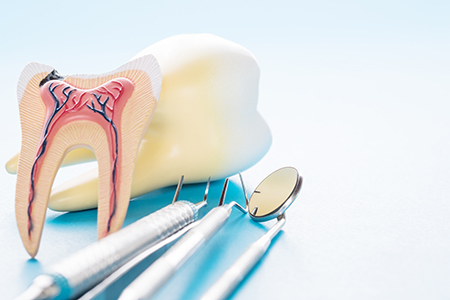Serving Avondale and the West Valley
Serving Avondale and the West Valley

If a dentist tells you a tooth needs a root canal, try not to panic. Modern root canal treatment is a precise, routine procedure designed to relieve the deep pain caused by an inflamed or infected dental pulp while preserving the function and appearance of your natural tooth. In most cases the experience is no more uncomfortable than having a large filling placed, and the end result is a restored tooth that can last for many years with proper care.
At the office of Summit Family Dentistry we combine up-to-date techniques with a calming, patient-focused approach. Our team prioritizes comfort and clear communication so you understand why a root canal is recommended, what to expect during treatment, and how to protect your restored tooth afterward. Our goal is to treat the underlying problem and get you back to eating, speaking, and smiling comfortably.
When the inner tissues of a tooth become damaged or infected, a root canal is frequently the most predictable way to preserve that tooth rather than remove it. Protecting your natural tooth helps maintain proper chewing function, prevents neighboring teeth from drifting, and avoids many of the long-term consequences that can follow extraction. Keeping the tooth also preserves the jawbone and supports a balanced bite.
Root canal therapy focuses on removing the inflamed tissue inside the tooth, disinfecting the space, and sealing it so the infection cannot reestablish itself. Thanks to modern instruments, materials, and imaging, clinicians can shape and clean the root canals thoroughly while minimizing patient discomfort. For many patients a successful root canal eliminates the need for more invasive procedures later.
Choosing to save a tooth typically requires assessment of the remaining tooth structure and surrounding bone support. When enough healthy tooth remains and there is a reasonable prognosis for restoration, endodontic treatment is the conservative choice that preserves function and appearance. Your provider will explain the expected outcomes and the steps needed to restore the tooth after treatment.

Each tooth has a central chamber that houses the dental pulp: a network of connective tissue, tiny blood vessels, and nerve fibers. While the pulp is essential for a developing tooth, a mature tooth can remain functional after the pulp is removed. Problems arise when deep decay, cracks, or trauma allow bacteria to reach and inflame this tissue, causing persistent pain or infection.
Symptoms vary depending on the degree of inflammation or infection. Some people experience sharp or throbbing pain that worsens with chewing or at night; others notice heightened sensitivity to hot or cold that lingers after the stimulus is gone. In other cases a tooth may darken, or swelling may develop in the gum or face, signaling an infection that needs prompt attention.
Not every ache requires a root canal, but certain signs merit evaluation so the appropriate treatment can be provided before the problem progresses. A careful clinical exam, sometimes supplemented by X-rays, helps determine whether the pulp can be saved through conservative means, requires root canal therapy, or in rare cases might need extraction.
Although many dental concerns show obvious symptoms, some teeth with significant pulp damage are surprisingly quiet. Routine exams and X-rays can reveal areas of bone loss or other changes at the root tip that indicate an infection is present even when pain is absent. Early detection improves the chances of a successful outcome and reduces the risk of complications.
Pain that persists or wakes you at night often indicates that the nerve tissues are irritated or infected. If over-the-counter remedies do not provide lasting relief, an examination is warranted to identify the source and determine whether root canal therapy is appropriate.
An uncomfortable, lingering reaction to hot or cold foods and drinks can be a sign of pulp inflammation. When sensitivity does not subside after the stimulus is removed, the pulp may be irreversibly damaged.
Pain on biting or sensitivity to light touch often points to internal damage or an infection that is affecting the tooth’s support structures. This symptom suggests the need for prompt evaluation.
A tooth that darkens after trauma or gradually loses its natural color may have internal changes to the pulp. Discoloration alone does not confirm a failed pulp, but it is a sign that merits further investigation.
Structural damage that exposes the inner portion of the tooth can allow bacteria to invade the pulp. Even small cracks can compromise the tooth’s internal tissues and lead to symptoms over time.
Swelling of the gum near a tooth, a persistent pimple-like bump on the gum, or any sign of drainage suggests an active infection. These findings should be addressed promptly to prevent spread and to alleviate discomfort.
Infection that extends to the bone supporting a tooth can cause looseness. In many cases root canal therapy, combined with appropriate restorative care, helps resolve the inflammation and stabilize the tooth.

Addressing pulp inflammation or infection in a timely way limits the potential for the condition to worsen. If left untreated, an infected tooth can lead to increasing pain, spread of infection to adjacent tissues, and more extensive damage to the tooth and jawbone. Early intervention often simplifies care and improves the long-term prognosis.
Some teeth show radiographic changes at the root tip before severe symptoms develop. Regular dental checkups and imaging when indicated let your dentist identify problems during their earliest stages, which increases the likelihood of a conservative, successful treatment outcome.
Even when a tooth has already developed an infection, root canal therapy is designed to remove the source of infection and allow the body to heal. Delaying care can complicate treatment, lead to additional procedures, or in some cases necessitate extraction if the tooth becomes unrestorable.
Root canal treatment begins with a thorough exam and an explanation of the recommended plan. On the day of the procedure, local anesthesia is administered to numb the tooth and surrounding tissues so the treatment is comfortable. If dental anxiety is a concern, additional calming options can be discussed before the appointment.
Once the area is numb, the dentist creates a small access opening in the crown of the tooth to reach the pulp chamber and root canals. Specialized instruments are used to remove diseased tissue, shape the canals, and irrigate them to remove bacteria and debris. Modern files and disinfecting solutions make this process efficient and effective.
After cleaning and shaping, the dentist fills the canals with a biocompatible sealing material to prevent reinfection. Depending on the tooth’s condition, treatment can often be completed in a single visit; more complex cases may require two appointments. Following canal filling, the tooth is prepared for a permanent restoration to restore strength and function.
A protective crown or appropriate restorative material is usually recommended after root canal therapy to reinforce the tooth and protect it from fracture. Your dentist will discuss the timing and type of restoration that best suits your tooth and overall bite.

At the office of Summit Family Dentistry we aim to make recovery straightforward and predictable by providing clear post-treatment instructions. Many patients experience some tenderness around the treated tooth for a few days as the surrounding tissues settle, but this discomfort generally diminishes with time and simple care.
Initially you may feel numb from the local anesthetic; normal sensation typically returns within a couple of hours. Over-the-counter pain relievers are often sufficient for managing mild discomfort, and your dentist will advise if a prescription medication or antibiotics are necessary based on the clinical findings.
While the canal space is sealed, the overall tooth remains vulnerable until it receives its final restoration. Avoid hard or sticky foods on the treated tooth and follow the recommended timeline for placing a crown or permanent filling. Maintaining excellent oral hygiene and attending regular dental checkups help preserve the treated tooth and detect any changes early.
After your appointment it’s normal to feel numb for a short time. Take care when eating or drinking until sensation returns to avoid accidentally biting soft tissues.
Mild soreness for a few days is typical and usually manageable with recommended pain relief. If pain increases or persists beyond the expected recovery period, contact the practice for an assessment.
If your dentist prescribes antibiotics to treat or prevent an active infection, follow the directions and complete the full course as advised.
Until a permanent crown or definitive restoration is placed, avoid heavy chewing on the treated tooth to reduce the risk of fracture. Temporary fillings are not as durable as permanent restorations.
Brushing and flossing remain essential after treatment. Good home care supports healing of the surrounding tissues and helps prevent future problems.
A final crown or restoration restores strength and function and helps the treated tooth remain a reliable part of your smile for years to come.
With accurate diagnosis, careful treatment, and sensible aftercare, a tooth treated with root canal therapy can continue to serve its purpose for a lifetime. If you have questions about whether root canal treatment is right for you or need guidance after a procedure, please contact us for more information.

A root canal procedure is the best way to save a tooth that has been damaged by decay or injury and preserve your natural smile. The alternative is an extraction and treatment to replace the tooth. While at times a tooth is non-restorable and an extraction is the only option, when possible, it’s best to try and save your natural tooth. With proper care, a tooth with root canal therapy can serve your smile well for many years to come.
Despite lingering myths from before the age of modern dental anesthesia and technology, having a root canal procedure today is as routine and comfortable as visiting the dentist for a filling. While the procedure is performed under local anesthesia with your tooth completely numbed, we can also discuss options in dental sedation.
Whether the symptoms of a dental infection subside after a course of antibiotics, a draining abscess provides you with some temporary pain relief, or a tooth with radiographic evidence of pathology has not yet developed symptoms, it’s essential, before an infection worsens or occurs, to have a root canal procedure performed. In this way, the tooth can be disinfected, filled, and sealed to protect your health and avoid further problems.
If you have sustained a dental injury, have a toothache, jaw pain, swelling, or are experiencing any other unusual and uncomfortable oral symptoms, contact our office immediately for care. Dental problems that have not been evaluated and treated can significantly worsen, producing more severe damage and consequences for the involved teeth, your oral health, and even your overall wellbeing. Once you get in touch with our office, our friendly and compassionate office team will get you in for care at your earliest convenience.
While some root canal procedures can be completed in one visit, others may involve 2 or 3 appointments. How long it takes depends on various factors, including active infection, the number of canals in the tooth, and the tooth’s location or anatomy.
With a success rate that exceeds 95%, root canal therapy remains the most effective procedure to save a tooth in which the inner vital tissues have been damaged. However, as with all healthcare procedures, there are a small percentage of cases where the teeth become symptomatic a second time. The good news is that many of these teeth can still be saved with root canal retreatment or a minor surgical procedure known as an apicoectomy.
The best ways to maintain a tooth with root canal therapy are to get the proper restoration required to rebuild and protect the tooth, maintain proper oral hygiene, and schedule appointments for routine dental checkups and care.
Saving a tooth with root canal therapy is a wise investment that, in the long run, is typically less costly and invasive than having the tooth extracted and replaced with a fixed bridge or implant. As far as the exact cost of care, it can vary depending on which tooth is being treated. Many dental insurance plans provide coverage for root canal therapy. At the office of Summit Family Dentistry, we do our best to optimize your dental benefits and minimize your out-of-pocket expenses. Our staff will answer all your questions about the cost of care and discuss all your payment options.
At the office of Summit Family Dentistry, we use the latest technology and most effective methods of care to provide precise and gentle care. Our reputation for excellence is based upon a consistent record of achieving successful treatment outcomes while providing prompt, stress-free, and convenient treatment for every type of dental need.
A root canal is a dental procedure that removes inflamed or infected pulp from the inside of a tooth to eliminate pain and preserve the natural tooth structure. The treatment cleans and seals the root canals to prevent bacteria from reentering the space and causing further damage. When the pulp is irreversibly injured by decay, cracks, or trauma, root canal therapy is often the most predictable way to maintain chewing function and avoid extraction.
Modern root canal care is precise and routine, using advanced instruments and imaging to thoroughly clean and shape the canal system. The goal is to save the tooth while restoring comfort and function so that you can eat and speak normally. At the office of Summit Family Dentistry our team emphasizes clear communication and patient comfort throughout the process.
Common signs that a tooth may need root canal therapy include ongoing, unexplained tooth pain that can be sharp or throbbing and often worsens with chewing or at night. Heightened sensitivity to hot or cold that lingers after the stimulus is removed and localized swelling or a pimple-like bump on the gum are also red flags. A tooth that darkens after trauma or shows pain when biting can indicate internal damage requiring evaluation.
Not all problematic teeth cause obvious symptoms; some infected teeth remain asymptomatic while showing radiographic changes at the root tip. Routine exams and X-rays help detect early bone loss or other signs of infection before symptoms escalate. Early assessment increases the likelihood of a successful and conservative outcome.
Treatment begins with a thorough exam and imaging, followed by local anesthesia to numb the tooth and surrounding tissues so the procedure is comfortable. The dentist creates a small access opening in the crown to reach the pulp chamber and root canals, then uses specialized files and irrigating solutions to remove diseased tissue, shape the canals, and flush away bacteria and debris. In many cases the canals are filled with a biocompatible sealer and gutta-percha in a single visit; more complex anatomies may require two appointments.
After the canals are sealed, the tooth is prepared for a permanent restoration that restores strength and function, commonly a crown for posterior teeth. Temporary restorations protect the tooth while the final restoration is fabricated and placed. Your provider will explain the recommended timeline and materials for restoring the treated tooth based on its condition and the overall bite.
Thanks to local anesthesia and modern techniques, most patients report that a root canal feels similar to having a large filling placed and is not more uncomfortable than routine restorative care. You may feel pressure during the procedure, but sharp pain is uncommon when the area is properly numbed. For patients with dental anxiety, additional calming options can be discussed before the appointment to improve comfort.
After treatment it is normal to experience mild soreness or tenderness for a few days as surrounding tissues heal, and over-the-counter pain relievers usually control this discomfort. If pain increases or does not improve within the expected recovery window, contact the practice for an evaluation. Your dentist will advise whether further treatment or medication is needed based on clinical findings.
Most patients resume normal activities the same day, with residual soreness gradually diminishing over several days as inflammation resolves. Numbness from local anesthesia typically subsides within a few hours, and simple analgesics are often sufficient to manage post-treatment discomfort. It is important to avoid chewing on the treated tooth until a permanent restoration is placed to reduce the risk of fracture.
The definitive restoration, often a crown, is scheduled according to the tooth’s condition and the dentist’s recommendations to restore full function and protect the tooth long term. Maintaining good oral hygiene and attending regular follow-up visits help monitor healing and detect any early signs of complications. With proper care, a root canal-treated tooth can remain functional for many years.
Not every tooth treated with a root canal needs a crown, but many posterior teeth and extensively damaged teeth benefit from a crown to reinforce structure and protect against fracture. Front teeth with minimal structural loss may be restored with a bonded filling or composite restoration when appropriate. The decision depends on how much natural tooth remains, the location in the mouth, and functional demands like biting forces.
Your dentist will assess the tooth’s remaining structure and discuss restoration options to provide lasting strength and a natural appearance. Timely placement of the final restoration is important because temporary fillings are not as durable and the treated tooth can be vulnerable until fully restored. The restorative plan is tailored to preserve function and long-term prognosis.
The primary alternative to root canal therapy is extraction of the affected tooth. While extraction removes the source of infection, it also results in loss of the natural tooth and can lead to changes in chewing function, drifting of adjacent teeth, and bone resorption if not replaced. Replacement options after extraction include dental implants, bridges, or removable prostheses, each with different advantages and requirements for surrounding teeth and bone.
Choosing extraction versus root canal therapy involves evaluating the tooth’s restorability, surrounding bone support, overall oral health, and patient preferences. Root canal treatment is often the more conservative choice when the tooth can be predictably restored, because it preserves natural tooth structure and maintains the integrity of the dental arch. Your dentist will review the expected outcomes and help you weigh the long-term implications of each option.
Although root canal therapy has a high success rate, reinfection can occur if bacteria remain in untreated canal branches, if the restoration leaks, or if a new decay allows contamination. Symptoms of reinfection mirror the original problem and may include pain, swelling, or radiographic signs of bone changes at the root tip. Timely review of symptoms and X-rays helps detect issues early and determine the best course of action.
When reinfection occurs, retreatment or endodontic surgery such as an apicoectomy may be recommended to address persistent infection and preserve the tooth. The choice depends on the cause of failure, tooth anatomy, and the condition of the existing restoration. If you have concerns about a previously treated tooth, contact Summit Family Dentistry for an assessment and treatment plan tailored to your situation.
Before your appointment, follow any specific instructions provided by your dentist regarding medications or pre-procedure care, and inform the team about medical conditions or medications you are taking. Eat a light meal beforehand unless instructed otherwise, as local anesthesia and mild sedation may be used and could affect coordination. Arrange for transportation if you plan to use stronger sedation or if you prefer not to drive after the procedure.
If you have dental anxiety, discuss calming options with your provider in advance so an appropriate plan can be made to help you relax. Bring a list of questions or concerns to the visit so your dentist can explain the procedure, expected recovery, and the plan for final restoration. Being prepared helps the appointment run smoothly and improves overall comfort and outcomes.
A dental emergency related to the pulp often involves severe, uncontrolled pain, rapidly increasing swelling of the face or jaw, or an active drainage tract that signals spreading infection. These signs warrant prompt evaluation because untreated infection can cause more extensive problems and significant discomfort. If you experience any of these symptoms, contact a dental provider right away for triage and to arrange timely care.
In the interim, over-the-counter pain relievers may help manage discomfort, and applying a cold compress can reduce swelling, but avoid placing aspirin directly on the gum or tooth. Do not attempt to lance or drain an abscess yourself; professional assessment is required to determine whether urgent root canal therapy, antibiotics, or another intervention is appropriate. Early treatment improves outcomes and reduces the risk of complications.

Ready to schedule your next appointment or have questions about our services? Our friendly team is here to help with everything from booking visits to answering questions about your treatment options. We’re committed to making the process simple and stress-free.
Whether you prefer to give us a call or fill out our convenient online contact form, reaching us is quick and easy. Don’t wait to take the first step toward a healthier, more confident smile—contact Summit Family Dentistry today!